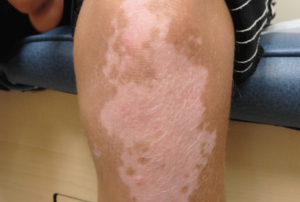Chapter 13: Disorders of Pigmentation
Hypopigmented and Depigmented Lesions: Vitiligo
What is it?
Vitiligo is an autoimmune skin condition involving the loss of melanocytes that results in depigmented, or white areas of skin. The cause of vitiligo is not well understood but it can run in families. In the end the loss of melanocytes leaves the skin completely white. Most patients develop vitiligo before age twenty. Vitiligo is generally asymptomatic but is often a significant cosmetic concern to patients and their families.

What does it look like?
Vitiligo is characterized by depigmented patches that often appear in a symmetric distribution. They are well defined and may have islands of residual pigmentation visible around hair follicles within the lesions. White hairs might be visible within the patches, which is a poor prognostic sign. It can be localized or segmental in nature, or it can present with more generalized lesions, which are commonly seen bilaterally on dorsal hands and feet, over bony prominences, on the face, and in the genital area. If needed, a Wood’s lamp can be used to differentiate depigmented skin (which appears fluorescent white) from hypopigmented skin (which may appear slightly lighter but is not white). Generally vitiligo is a clinical diagnosis and a biopsy is not required.
How is it treated?
Vitiligo is difficult, but not impossible, to treat. Treatment begins with the highest potency steroid appropriate for the site. Steroids are used daily, but with occasional breaks such as 4 weeks on and 2 weeks off, for several months to see if any response will be noted. Topical calcineurin inhibitors, usually tacrolimus 0.1% ointment can be utilized on areas that cannot be safely treated with potent topical steroids and can be rotated with topical steroids for other locations. If there is no improvement within a few months, continued therapy is not likely to be effective. Phototherapy with narrow-band UVB, PUVA, or excimer laser can be helpful where it is available. Ambient sun exposure can be helpful in stimulating repigmentation, but is often not recommended as a treatment due to an increased risk of sunburn in depigmented areas and increased prominence of skin changes when normal skin becomes more tan. There is an association with vitiligo and other autoimmune conditions, especially autoimmune thyroid disease. Laboratory investigations are not routinely required but may be needed if patients have systemic symptoms that suggest an underlying autoimmune condition. If indicated a CBC, fasting blood glucose and TSH can be checked.

